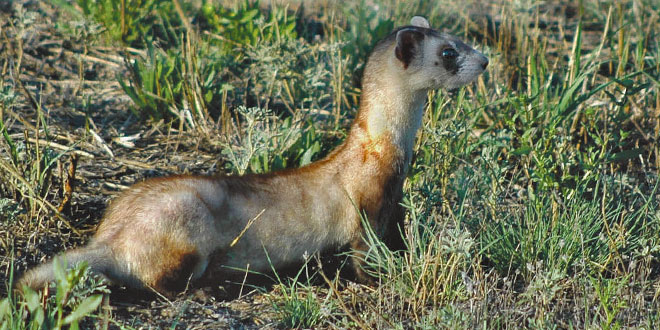Ferrets, cool jobs, and more
Including interactive activities: Animal eyes, Cold water fish vs. warm water fish.
Ferrets & Weasels:
What’s the difference?
Last year, the Department of Game and Fish released eight black-footed ferrets on a ranch in northeast New Mexico. Black-footed ferrets are endangered.
When a species is endangered, that means that it is in danger of going extinct, or disappearing forever.
Black-footed ferrets, probably the rarest mammal in North America. It can be easy to mistake black-footed ferrets for other animals in the same family that look very similar: the long-tailed weasel and the European ferret.
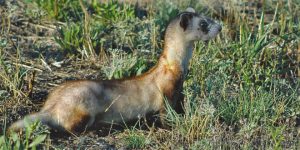


Above: Black-footed ferret; Bottom: Long-tailed weasel. Department photos by Jim Stuart.
How can you tell the difference between these three animals?
The black-footed ferret is approximately two feet long including its tail. It is yellowish in overall color. It has a black face-mask and a white snout. It is most often found in prairie dog towns. It has not been found in New Mexico in many years.
The long-tailed weasel looks very similar to the black-footed ferret. It may also have a black face-mask and black tail tip, but the feet are light colored. The body color is often yellowish to reddish brown with a light belly. It is about half the size of the black-footed ferret. The long-tailed weasel is common in New Mexico, usually in rocky or wooded areas, where it hunts rodents.
The European ferret, also known as a polecat, is about the same size as the black-footed ferret. However, it has a more pointed muzzle, or nose, more black on the tail and bushier fur. The European ferret is domesticated, meaning is can live with humans. It is a popular pet.

Above: European ferret.
Animal eyes
Whose eyes are these?
Take a look at the six pairs of eyes. Can you tell what animal each pair belongs to?
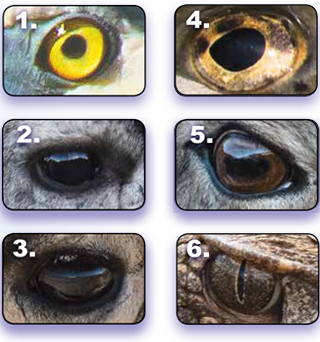
Answer Key (click to view)
- Great blue heron
- Mule deer
- Pronghorn
- Rio Grande cutthroat trout
- Rocky Mountain bighorn sheep
- Western diamond back rattlesnake
Kids Tracks
Download & print Kids Tracks from
a PDF file format:
Kids Tracks: Vol 21 #1 – Spring 2019
Ferrets & Weasels, Cool Jobs, Animal Eyes Quiz and more.
Cool Jobs at Game & Fish
Meet Kevin Holladay
Hello! My name is Kevin Holladay. I am the conservation education program manager for the New Mexico Department of Game and Fish.
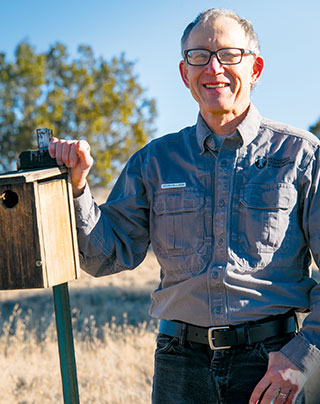
Above: Kevin Holladay, former conservation education program manager, checks a bluebird nesting box. Department photo by Martin Perea.
I was very fortunate to have parents that loved spending family time outdoors; fishing, tent camping and hiking out West. In 5th grade our family moved out of town to an old farm with a creek and pond to fish and prairie to get lost in. Joining Boy Scouts, I learned that some scientists don’t wear white lab coats but go outside to study wildlife through radio collars, trap and release, tracking, scat, pellets and other signs.
I majored in biology at the University of Kansas and took a few field natural history classes where we banded birds and caught rattlesnakes. After graduation, I volunteered with the Student Conservation Association at Glacier National Park and then Canyonlands National Park. Those positions helped me get park ranger jobs at Zion, Yosemite, Olympic, Katmai, Glacier Bay and Arches National Parks. During that time, I earned my master’s degree in education with a minor in wildlife.
I always wanted to see Africa, so after I finished my master’s degree I wrote a few letters and was accepted for an internship with the Kalahari Conservation Society in Botswana. After a year travelling in Africa, I came home and wanted to settle down.
When I got this job at the department, I felt like I had won a big lottery! One of my main tasks is to share with students and teachers how to fish; spin casting and fly fishing while developing a strong conservation ethic. I have been able to teach teachers how to incorporate fishing and wildlife field studies into their lesson plans and school grounds.
One thing I love about my job is that I am part of a noble mission going back to 1903 when our department was created—to conserve wildlife for future generations.
Cold water fish vs. warm
water fish
New Mexico’s lakes, river and streams are home to many different kinds of fish. There are two different types of fish in our state—cold water fish and warm water fish. Cold water fish are fish in the Salmonid family. They occur in higher elevation cold water lakes and streams” with water max temperatures less than 65°F and prefer water much cooler. Ideally 40-50°F range water with high dissolved oxygen.
Cold water fish can be omnivorous but general feed on aquatic macroinvertebrates (trout) and plankton (salmon). Warm water fish are also called spiny ray fish. Warm water fish occur in lower elevation large reservoirs, lakes and ponds and rivers with summer water temperatures >65°F.
Warm water fish are primarily piscivorous — meaning they eat other fish — when adults but can feed on a diverse diet including crayfish, small mammals, amphibians, etc.
Can you identify these fish? Cold water: Kokanee salmon, Gila trout, rainbow trout. Warm water: largemouth bass, walleye, Northern pike, Channel catfish , bluegill.
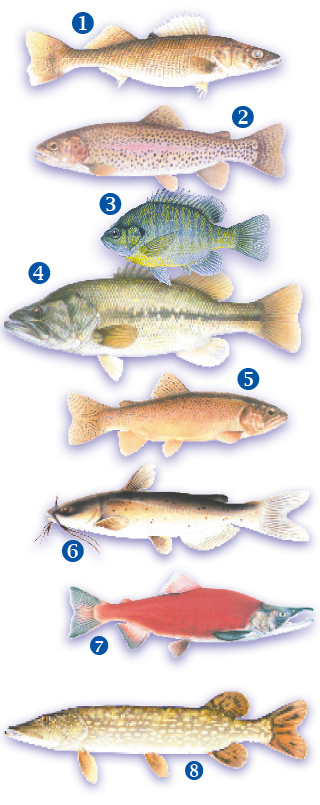
Answer Key (click to view)
- Walleye
- Rainbow trout
- Bluegill
- Largemouth bass
- Gila trout
- Channel catfish
- Kokanee salmon
- Northern pike.
 New Mexico Wildlife magazine Conserving New Mexico's Wildlife for Future Generations
New Mexico Wildlife magazine Conserving New Mexico's Wildlife for Future Generations
